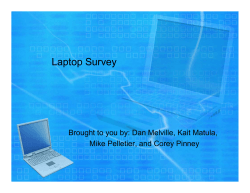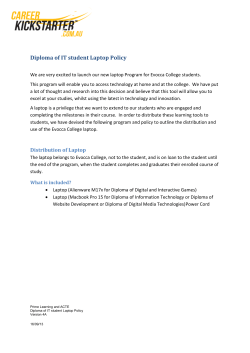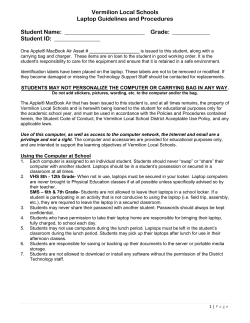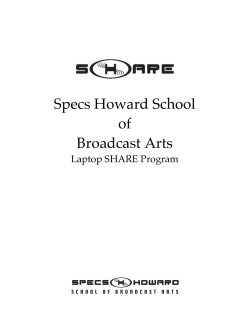
Final project: XO Laptop Group 7 1. Introduction
Final project: XO Laptop Group 7 International Business: Context & Strategies SSAM S-137, Harvard University Summer School 1. Introduction This document is the final project of the International Business course at Harvard University Summer School. The goal of the final project is to prepare a plan for a new product entry into a foreign market, in this case low-cost XO laptop entering India. In the following sections the paper describes details of the XO laptop and the entry strategy. It also covers analysis of the market, chosen primary target market and our campaigns. Then we discuss financing, sourcing and distribution. Finally, we present possible risks, sales forecast and expected profit. 2. Product description The development of the product was initiated by Nicholas Negroponte, co-founder and director of the MIT Media Laboratory, in January 2005. The aim of the initiative called a $100 laptop initiative was to develop a low-cost portable computer for educational purposes in developing countries. The initiative attracted several leading companies in the IT industry (e.g. AMD, Google, Red Hat, eBay) started with MIT Media Laboratory the development process under the codename One Laptop per Child project. Hence the first machines called XO laptops rolled off the assembly-line in Shanghai, China, in November 2006. When designing the XO laptop, the development team put stress on the factors of the environment in which the laptop will be used – poor infrastructure in terms of networks and electricity, dusty environment, unfavorable light conditions. Therefore it has several distinctive competitive advantages in terms of design and functionality compared to its competitors. One of the break-through technologies used in the XO laptop is its screen,which is developed and patented by MIT. Not only it has standard parameters of regular laptop screens, but furthermore it doesn’t need back-light. The screen has the functionality of both laptop screen and e-book reader. The XO laptop can therefore be used in environments where the screen is exposed to direct sunlight without any difficulties for the user. Eventually, XO laptops can be used as a substitude for printed text books. Another important advantage of the XO laptop is that it has a very efficient power management that brings low power consumption. This enables long battery life and alternative power sources in locations with poor electrical infrastructure. The XO laptop’s battery can be charged for example with a small $15 solar panel, car battery or hand-generator. More over, the appearance of the XO laptop was designed by Yves Behar, the Brand Man according to BusinessWeek1. The design had to be playful, because the primary target market is children. At the same time, it had to be durable considering possible environments where the XO laptop is supposed to be used in. The final design is a combination of a laptop and a game console. The XO laptop has a handhandle so that it is easy to carry. The XO laptop includes up-to-date technologies in terms of connectivity and software. It has fullscale wireless capabilities and internet support, and also it has an integrated webcam and microphone. It can be connected with other peripherals through USB ports. Basic input comes from the keyboard and dual touchpad that enables written-input mode. Although the manufacturing cost of $100 is significantly lower than of any other laptop. It is a hightech device that is going completely to change the computer industry.2 3. Overall strategy of entry Our main strategy will be a low-cost strategy. All XO laptops will be highly standardized to achieve economies of scale and obtain a price per unit as low as possible. Every single component of the XO laptop is intentionally designed to be as cheap as possible, which leaves us in a competitive advantage against other computer manufacturers that are forced to use their current manufacturing facilities. Their facilities and products are designed to utilize their experience in design and manufacturing, which comes from products for different primary target market. In order to establish a strong position in Indian market, the structure of our company will be a joint venture with Indian leading IT companies3. We are planning to offer 10% share to Wipro and Infosys Technologies. There are also other possible alternatives, which are other large IT employers in India (e.g. Tata Consultancy Services, Cognizant Technology Solutions, and Satyam Computer Services)4. Furthermore we are going to establish strategic alliances with Indian major technical universities. Our partners will develop both new software and content for the XO laptops, which will be fully localized to satisfy needs of our customers in India. Moreover, such strategies are expected to help create a positive image of our presence in India and give us easier access to India’s government officials. Our partners on the other hand will gain, besides additional income and increased brand awareness, access to an interesting market with large potential – educational IT services. The processor unit in the XO laptop is supplied by AMD and, XO laptops with AMD have already been deployed in several countries in Africa and Latin America. Since Intel joined the project in April 2007 5, we are planning to use Intel processors in India. Intel will be able to concentrate on its core business, which is processors’ manufacturing and at the same time, won’t introduce its Classmate laptop6 1 The Brand Wizard: Yves Behar. (2005) BusinessWeek. Retrieved on July 7, 2007 from http://www.businessweek.com/magazine/content/05_31/b3945411.htm 2 Hille, K. (2007). The race for the $100 laptop. Financial Times. Retrieved on July 10, 2007 from http://www.ft.com/cms/a/92d94ba6-24e4-11d8-81c6-08209b00dd01,id=070408002856,print=yes.html 3 Maidment, P. (2006). India’s Biggest? Think Oil, Not Tech. Forbes 40 India. Retrieved on July 13, 2007 from http://www.forbes.com/2006/07/28/india-oil-banking_cx_pm_0731india40intro.html 4 Iype, G. (2005). India’s top 10 IT employers. rediff.com. Retrieved on July 13, 2007 from http://www.rediff.com/money/2005/jun/10bspec.htm 5 Intel joins $100 laptop project. (2007). Bangkok Post. Retrieved on July 14, 2007 from http://www.bangkokpost.com/breaking_news/breakingnews.php?id=120156 6 The Classmate PC powered by Intel for Emerging Markets Worldwide. Intel World Ahead Program website. Retrieved on July 14, 2007 from http://www.intel.com/intel/worldahead/classmatepc/ in India, because the partnership meets Intel’s goal of the Classmate project. Furthermore we will be able to use Intel’s “Intel inside” co-branding marketing campaigns7. 4. Market analysis India is a rapidly growing economy. After half century, it has overcome all its odds and has achieved phenomenal standards of economic stability. The middle class in India is growing rapidly and the country is ranked as fourth in the world in terms of PPP GDP, after US, China and Japan. However, India has a very wide unequal distribution of income, which can be seen with the GDP per capita of $3800 in 2006. The middle class in India consists of three sub-classes: the upper-middle, middle-middle and lowermiddle class. The upper-middle class comprises of about 40 million people. The annual income of the upper-middle class is $600,000 per capita in terms of Purchasing Power Parity (PPP). The middlemiddle class comprises of about 150 million people, with annual PPP income of $20,000 per capita. The lower-middle class comprises of about 110 million people. An estimate of their annual income is not available, but they are mostly the relatively affluent people in the rural areas of India. The middle class is expected to grow in total by 5 to 10 percent annually. By 2004 estimates, the population of India is 1,065,070,607. Children in the age group of 0-14 constitute 31.7% of India’s population, which are about 337,873,771 children. By a modest assumption, we assume that 40 % of this population is in the middle class bracket. This makes the middle class children population to reach 135,149,500. With another assumption, we assume that 40% of these children are in the age group of 7 - 14 years, which are 54,059,800. Therefore the market potential of our product targeting our main consumer is roughly around 54 million XO Laptops. The Indian consumer today is very conscious in terms of focusing on education and updating itself in terms of technology. Therefore to reach out the largest group which is the masse, we have chosen the XO laptop with a price of 150 dollars to penetrate this huge untapped market. The Indian consumers are not aware of laptops as the consumers in the United States are. However, according to Manufacturers' Association for Information Technology (MAIT), and India’s hardware industrial lobby, Indians have started purchasing notebook computers faster than the industry would have thought. The notebook sales grew at 94 percent in the first half (April-September 2005) of the fiscal year 2005-06. On average, the prices of entry-level notebook computers now range from $800 to $1000, compared to prices of $1500 to over $2000 that prevailed about 12 to 18 months before. Moreover, notebooks now cost only around $200 more than a high-end desktop personal computer, which is also driving many desktop buyers to opt for notebooks. Therefore it has been proved that price plays an important role in penetration of the Indian Market. Therefore the price of XO Laptops is one fifth of the available laptops in India. The XO Laptop will focus on children who do not have any experience in using laptops. So, at that price, middle class parents will not hesitate to buy a product which would help their children’s talents to improve and grow. English is a common language and gaining ground in India, therefore there will be a low level of cultural risk involved in introducing the product in the market in English language. As India is a huge country with a population of more than 1 billion, the risk cannot be overlooked. Therefore at the time of entry, the laptops will only be available in English language, however later on, different language versions will be introduced in the market. 7 Norris, D. G. (1993). ″INTEL INSIDE″: BRANDING A COMPONENT IN A BUSINESS MARKET. Journal of Business & Industrial Marketing, Vol. 8, Num. 1. 4.1. Competition The PC industry is generally an industry with tough competition in terms of price. Our potentially strongest competitor is Dell with its desktop computer EC 280 priced at $337 that was introduced in Chinese market in 2007.8 Combined with a cheap monitor the final price is around $400. Our major advantage against Dell is in this case not only price but also portability of the XO laptop. Chinese Lenovo introduced its low-cost Xuri 125 laptop priced at $660 in China in 2006.9 Besides competitors that have their products available in the Chinese market, there are several other R&D projects aiming at low-cost computers. HCL, an Indian computer manufacturer, is designing a $300 laptop. Production is expected to start in 2009. Microsoft’s R&D for a $450 laptop is expected to bear fruit between 2009 and 2010. But „analyst see some of these moves as no more than public relations campaigns, defensive attempts to make sure that the respective company's brand or technology has a foot in the door once these countries turn into real markets“10. The first movers advantage should give as an upper hand when entering the market in full force. Our greatest threat in terms of competition is Intel’s Classmate laptop produced at $250. But our partnership with Intel and Intel’s processors in the XO laptops should eliminate the threat. As far as software is concerned, our main competitor is Microsoft and its operating system and office applications. We don’t consider switching cost to be an important issue because our primary target market are users that haven’t had a computer before. Moreover, XO laptop is fully compatible with documents made on Microsoft’s platform and also enables complete access to internet services. XO laptop’s software will be fully localized and developed by our Indian partners, which in our opinion will represent an advantage for us. Furthermore, Microsoft is also developing Windows version of the XO laptop, which represents a software contingency plan for us.11 5. Promotion The XO Laptop has two different promotion strategies. The company plans to promote the laptop to two different target end-consumers. The first one is children between 6 to 14 years old, and the second ones are the parents of these children. Therefore, the company will have two different messages (both of them will contain Exploring, Expressing, Learning and Resource lines) for the two target consumers. Formerly, “the children’s message” will focus on how trendy, playful and helpful the laptop is. The second promotion message of the Company, targeting the parents of the children, will focus on the helpfulness of the laptop for their children’s education career so that the chance of their children to attend one of the American Universities will increase. In order to promote our XO laptops, our company will use several different communication Channels. We will use Television and Cinema Communication Channels rather than newspaper and magazines because its revenue is gaining market share over the other promotions channels especially in the last 10 years. 8 Nairn, G. (2007). WHAT’S NEW: Dell tailors a desktop PC to the Chinese market. Financial Times. Retrieved on July 9, 2007 from http://us.ft.com/ftgateway/superpage.ft?news_id=fto041820070524452572 9 Lei, Z. Y. (2006). Great summer PC sell-off aimed at students and SMEs. Hong Kong Trade Development Council. Retrieved on July 12, 2007 from http://www.tdctrade.com/imn/06071803/computer004.htm Hille, K. (2007). The race for the $100 laptop. Financial Times. Retrieved on July 10, 2007 from http://www.ft.com/cms/a/92d94ba6-24e4-11d8-81c6-08209b00dd01,id=070408002856,print=yes.html 10 11 Sanders, T., Briggs, P. (2006). Microsoft looking to run Windows on OLPC. vnunet.com. Retrieved on July 10, 2007 from http://www.vnunet.com/vnunet/news/2170209/microsoft-looking-windows-olpc First of all, cinema is used in order to reach the children and their parents. One of the reasons to use cinema is the fact that most Indians go frequently to cinemas. Secondly, the Indian film industry is the largest in the world in terms of tickets sold in the movie theatres and in terms of the number of movies produced annually. In addition to the fact that the greatest amount of tickets sold in India, the movie tickets in India are 6 times cheaper than the tickets sold in any other part of the world. Secondly, television is used as another channel to market the XO Laptops. Television is very popular among Indian families, even though most of its population lives in poverty. In India, over 1,877,000 people have access to the television which shows the significance of the television. In addition, the time to display the XO Laptop is another significant task. The time when the XO Laptop will be shown on the television should be set according to the time when children are at home. So between 7.00 am to 9.00 am in the morning every day and between 4.00 pm to 6.00 pm in the evening every day and finally every Saturday morning from 8.30 am to 11.30 am the XO Laptop should be displayed on the television. Moreover, our company will form an agreement with the Indian Government and with the Indian ministry of Education. Our company will take the admission of the government in order that we can go directly into the primary, secondary schools and promote our product through “road show activities”. Our company will agree with schools in India on the time of activity and also we will advice in advance parents and children. Then, we will pop around the city with the buses, which are going to be full of printed ads on them. With this opportunity we will explain to the parents and children how our product works, and how to manage it. Regarding the frequent use of the internet, web site is another communication channel that our company will use to promote our product because Indian citizens and especially children have access to the internet and to the websites related to education services. Further more, we will put our PR “flash articles” which will appear inside the current used websites. Also, our PR will help to support the other communication channels. Other than using frequently used worldwide websites, we will definitely put the ads of our product on the largest India’s educational Portals such as www.wonderwhizkids.com , www.aicte.ernet.in , www.cbse.nic.in, www.indiaeducation.info . Finally, our company will sponsor (at least the first 2years) cricket matches, and selected public events. Cricket is extremely popular in terms of participation to the activity and supporting it. 6. Sales forecast The number of PCs sold in India in 2005 - 2006 was 4.65 million desktops. The market has been growing with a CAGR of 25 %. The projected sale of desktops in 2006 - 2007 is 5.6 million. In comparison, 430 thousand of notebooks were sold and there was a growth of 144% by year on year. The growth of notebooks can be assumed to be really high with the low prices of the notebooks. Therefore it can be assumed that XO Laptops will have a more potential sale of desktops as it is half or one third the price of a desktop in India. As price is the main factor determinants of the growth in this market and as there is a huge market potential of 54 million units, we plan to capture at least 5% of the market which is about 2.7 million units in the current year of operations. 7. Sourcing The components of the XO laptop are manufactured in East Asia – in China, Taiwan and Thailand. The final assembly is done by Quanta Computer, a Chinese company that is the world’s largest manufacturer of notebook computers12. According to OLPC Quanta Computer Company, they are going to set up a new assembly line for XO laptop in Singapore that is going to produce the final version of XO laptops. The new assembly line is supposed to start, at full scale, by the end of November 2007. The manufacturing costs are $100. However, Quanta’s regular margin is 3% for laptops between $400 and $500.13 Considering Quanta’s costs and profit margins, we are planning to negotiate the price for XO laptops between $110 and $118 per unit. The headquarters will be located in Chennai (formerly known as Madras Free Zone). Chennai is a port cluster with well developed plots, built up factory space and incentives. The port is located in a duty free import zone, which saves 19% in duties (Additional Duty of Customs 12%, Special Additional Duty 4%, Central Excise Education 3%)14. The trade in the cluster has been growing 58% annually in the last ten years and the highest share has had the electronics industry (67%). The annual rental cost for central warehouse and offices in Chennai will be $171,171. The freight and logistics between Singapore and Chennai will be handled by Japan Express Co., Ltd., member of the MOL Group. The price per container carrying 6,000 laptops will be $855.85 with 6 days transit time. Another MOL Group member, MOL Mitsui O.S.K. Lines, will handle the transport and logistics in India. 8. Distribution strategy In this part, we will examine how to distribute our product to the end consumers. First of all, we will set up five major warehouses throughout India; in the South, North, East, West and Central parts of the country respectively. As the laptop is quite small, the size of the warehouses will be limited. We will rent the locations, in order to reduce potential barriers to exit and increase flexibility. The price of renting warehouses is low in many parts of India. When determining the amount of laptops to be stocked, there will be a trade off between transportation costs and inventory cost (i.e. rent etc.). In order to distribute our product to the end consumers, we originally wanted to cooperate with nationwide electronic chains. However, the only chains existing in India are single-brand stores, offering products from one single brand exclusively (e.g. Sony, HP etc.). Rather than solving this lack of suitable infrastructure by setting up a large number of subsidiaries throughout the country, we decided to distribute the XO laptop through stationery shops. These stores sell paper and writing equipment, as well as cell phones and phone cards. By offering the laptop in such locations, we believe that we will reach our target customers, children aged between 6 to 14 and their parents, in a situation where they are already looking for educational equipment. This may be beneficial, as we have reason to believe that the potential consumers in such environments will be receptive of promotional activity and will be open for new solutions. Many schools have their proper stationery stores, situated inside the schools’ area. This creates closeness to the consumers and the user context that can prove to be of significant importance for our sales, as well as for our marketing costs. Furthermore, Indian stationery stores currently do not offer Hille, K. (2007). The race for the $100 laptop. Financial Times. Retrieved on July 10, 2007 from http://www.ft.com/cms/a/92d94ba6-24e4-11d8-81c6-08209b00dd01,id=070408002856,print=yes.html 12 Einhorn, B. (2005). Quanta's $100 Laptop Challenge. Business Week. Retrieved on July 10, 2007 from http://www.businessweek.com/technology/content/dec2005/tc20051220_069981.htm 13 Use of tariff to calculate Customs Duty. eximtimes.com. Retrieved on July 5, 2007 from http://www.eximtimes.com/cexim/custtariff/cst-note.htm 14 laptops, providing us with a potential first-mover advantage. Each store should have a laptop on display for children to try. The local stationery shops receive their products through a number of large distributors. In an attempt to minimize transportation costs and take advantage of distributor loyalty, we will cooperate with these distributors and have them come pick up our merchandise in the central warehouses. The laptops will then be shipped to the end distributors by trucks or other vehicles. 9. Financing We are planning to have two financial sources – capital from our Indian partners and long-term bank loan. In the first case we are expecting inflow of capital from Indian IT companies as an exchange for their share in the company. Considering every aspect altogether, 20% of our company will belong to Indian IT companies. If additional capital is needed, a long-term bank loan will be taken. The bank loan will be negotiated through our Indian partners who have good credit ratings. The operating profit in the first year is expected to reach $220 mil. 25% of the net profit will be paid to the shareholders and 75% will be re-invested back into the company. Revenue/Costs ’000 TR = 540000 TC (FC+VC) = 40340 + 308455 FC = 40340 0 BE Units = 470,700 Units Figure 1 Break-even analysis The break-even point will be reached after selling 470,700 XO laptops. 9.1. Speculation of monetary exchange rate Singapore manufactures one laptop which will cost 100.00 USD ($) and the manufacturers want some profit. So, our company negiotated to have the final prices of $118.00. However we will pay 181.00 SGD (S$) with using the speculation monetary plan. In addition we agreed with the Reserve Bank of India to have an agreement of monetray plan for the year 2008..So, our material cost which is $297,000,000 will be S$ 456,923,077 with the current exchange rate. We also agreed on the fixed exchange rate and on the profits we will have thanks to this financial plan. Then, we are going to take from the Reserve Bank $ 24,750,000 every month which corresponds to S$ 38,076,923 every month. Taking the spot exchange rate into account, $1 is S$ 1,54. In addition, because of the long plan, we will decide whether to have a plan of 30, 90,180,270 or 360 days. To profit more, we will have a long plan of 360 days. So, S$ 1.54 spot exchange rate will be S$ 1.56 in the long term plan. Therefore we are going to save 1,28% of our savings thanks to the exchange rate. 10. Risks 10.1. India’s overall attractiveness When determining a country’s overall attractiveness, one must consider the benefits, costs and risks of operating in that country (Hill, 2007). Benefits comprise the size of the economy and the likely economic growth, while the costs are driven by corruption, lack of infrastructure and legal costs. Risks can be categorized as political, economic or legal. We will here discuss the attractiveness of India, especially stressing the risks associated with operating in the country. 10.2. Benefits As we already mentioned when describing the market conditions, India has the world’s largest population and thus represents a huge potential market for our product. Moreover, India has the 6th largest economy in the world, with a GDP of $4.156 trillion 15, and a growth rate of almost 10 % per year. It is thus safe to say that the market conditions in India are beneficial. 10.3. Costs Being a democracy with a sophisticated economy, one would expect the costs of doing business in India as relatively low. However, corruption is widespread in the country, which is shown by it’s low score (3,3) on Transparency International Corruption Perception Index 16(CPI). As for the use of bribery, Indian companies’ propensity to bribe is worse than all other major exporting countries in the world17. We may therefore be expected to bribe government officials as well as local distributors in order to get our product to the customers, who represent an economic cost as well as an ethical dilemma. 10.4. Political Risk Political risk can be defined as “the likelihood that political forces will cause drastic changes in a country’s business environment that adversely affect the profit and other goals of a business enterprise” (Hill, 2007). Such risk tends to be high in countries where social unrest and disorder result in strikes, demonstrations, violent conflict and terrorism. India is a democratic federal republic with a multi-party system. For most of its independent history, the country has been ruled by the Indian National Congress. Between 1996 and 1998, there was some political instability due to the failure of any party to obtain an absolute majority in Parliament. However, since the general elections in 1999 political stability has been re-established18. As all Indian parties recognize economic liberalisation as a necessity, a potential change of government poses no real threat to the country’s business environment. Furthermore, there is no important revolutionary movement in India, and thus no real possibility of a collapse of the state. Strikes and demonstrations do occur in India, but the likelihood that such incidents will cause drastic changes in the business environment is practically equal to zero. As for terrorism, no terrorist 15 World Factbook 16 http://transparency.org/policy_research/surveys_indices/cpi 17 http://transparency.org/news_room/latest_news/press_releases/2006/en_2006_10_04_bpi_2006 18 http://www.wikipedia and Anirudh. unity is strong enough to disturb the state. With the exception of the Kashmir region in the north, any terrorist activity is too weak to be of any significance19. However, there may be specific risks linked to our project. The Indian Government rejected the XO laptop offered by OLPC foundation in 2006, and has instead started developing its own low cost laptop, with an aim price of $10 20. Therefore we can assume that the government might not support us at the beginning. Nevertheless, we believe that the government will consider the fact that our product is ready to enter the market immediately. In order to get through to the government officials, more precisely to the Ministry if Education, we will use the network of our Indian partners (companies and universities). Even though we consider government support important for entering the market, it should not be crucial for a successful entry. Many parental organizations are sceptical to distributing laptops with internet access to children, due to the potentially harmful content children can access21. If these groups team up, the result may be a lot of negative publicity concerning our product. This may take the focus away from the benefits our product can give to the children. We saw how influential the media was in shaping people’s perception about the entry of Dubai Ports into the operations of American ports. By developing parental filters and communicating this with the market via the media, we can reduce the impact of such negative publicity. 10.5. Economic Risk The economic risk is the likelihood that economic mismanagement will result in drastic changes in a country’s business environment (Hill, 2007). Indicators of such mismanagement may be the country’s inflation rate, its level of business and government debt. India’s current inflation rate, as measured by the consumer prices index (CPI), is 5,3 % 22. The rate is higher than its 2000 level of 3,5 %, and 4,4 % in 200523. Compared to the inflation rates of the United States and the European Union, 5,3 % is a relatively high number. However, this inflation rate goes hand in hand with an elevated growth rate of 9,2 % 24. When we consider this, the inflation does not represent a source of economic risk in India. As for the public debt, this represented 52,8 % of GDP in 2006. India has the 44th largest proportion of public debt relative to GDP worldwide. In comparison, United States’ public debt constituted 64,7 % of the country’s GDP in 2005, leaving it in 30th position. The external debt of India is $132,1 billion (2006)25. The debt level poses no economic risk for the business environment. The Indian currency, the rupee, has appreciated heavily over the last couple of months, due to large inflows of capital. The currency has been pushed up more than 9,5 percent so far in 2007, making it Asia's best performing currency and forcing the central bank to intervene to protect exporters' margins26. As the laptop will be imported to India from Singapore, the strong rupee represents an advantage for our business. Figure 1 shows the development in the exchange rate between Singapore dollar and the Indian rupee over the last months. It shows a stable appreciation of the rupee relative to the Singapore 19 Anirudh. 20 http://www.eetasia.com/ART_8800463626_499495_NT_9ba7d713.HTM 21 www.indianchild.com 22 World Factbook 23 World Factbook 24 World Factbook 25 World Factbook 26 http://www.x-rates.com/d/SGD/INR/graph120.html) dollar. However, the fluctuation of the exchange rates remains normal, and does not represent an economic risk. Figure 2 Exchange rate between Singapore dollar and Indian rupee 10.6. Legal Risk A country’s legal risk is high if it is likely that a trading partner will opportunistically break a contract or expropriate property risks (Hill, 2007). The XO laptop will be produced in Singapore and sold in India. Thus, both countries’ legislation regarding intellectual property rights (IPRs) will affect the legal risks faced by our company. Piracy is a big problem in most Asian countries. However, the laptop uses open source software, and piracy of the software is therefore not a threat. The real legal risk thus lies in Singapore, where the production takes place. The innovative technology and cost minimizing design are among the company’s core competencies, and copying of these characteristics represent a real risk to our business. As Singapore is moving towards a knowledge-based economy, it has reinforced its legislation regarding IPRs27. Moreover, the government has increased inspections and developed education on the area. We, therefore assume that potential attempts to copy the laptop qualities will be severely punished. The legal risk of the business thus appears to be quite limited. 11. Conclusion India is a large market with enormous potential of growth. With low-cost strategy we expect to reach large market share in the first year with 2.7 mil. sold XO laptops. To increase the acceptance of the product we’ll form partnerships with major IT companies and universities in India. Through our partnerships we’ll be also able to localize the product. Estimated operating profit for the first year is $220 mil., break-even point will be reached after selling 470,000 XO laptops. 27 http://www.ida.gov.sg/Policies%20and%20Regulation/20060526115554.aspx
© Copyright 2025













